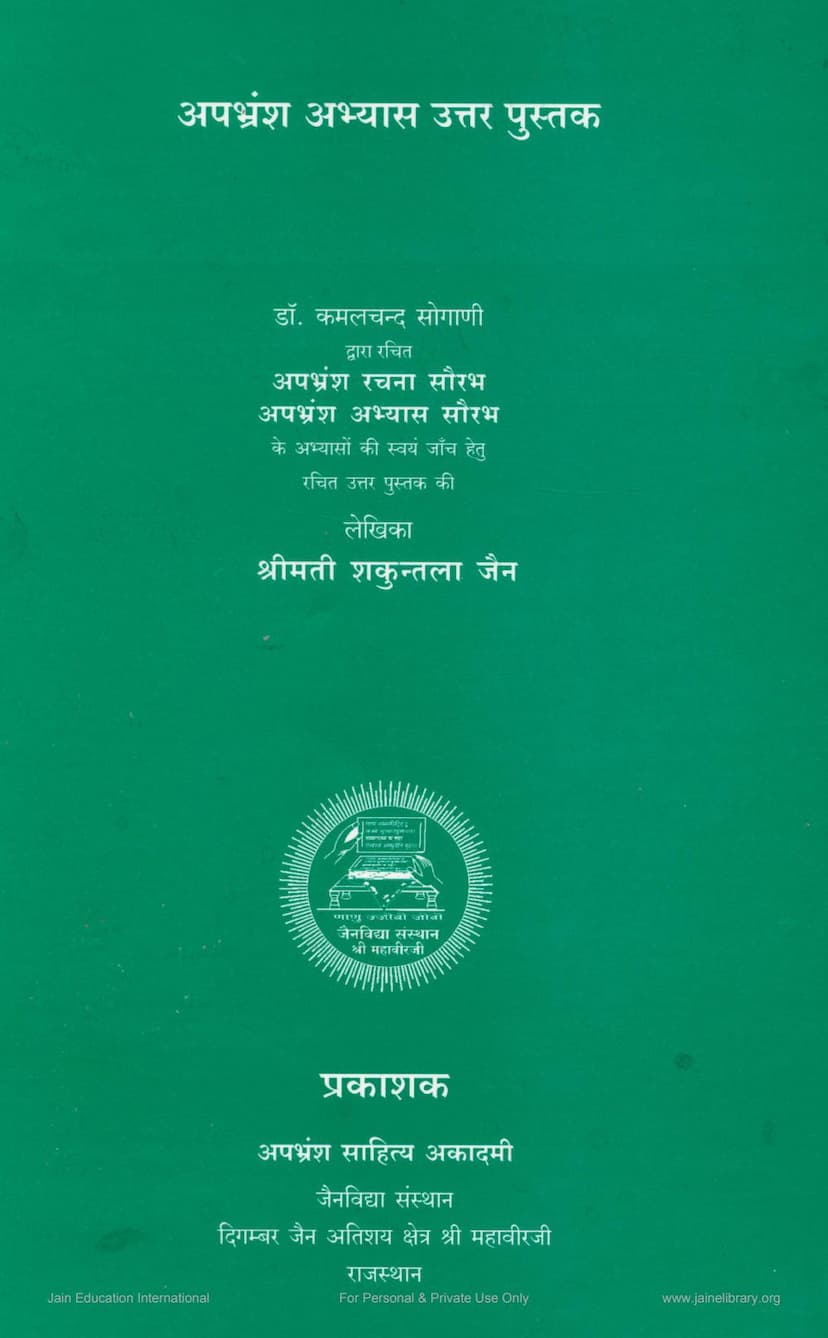Apbhramsa Abhyas Uttar Pustak
Added to library: September 1, 2025

Summary
This document is the answer key for the book "Apabhramsa Abhyasa Saurabh" (आ the Apabhramsa practice book). It is titled "Apabhramsa Abhyasa Uttar Pustak" (अपभ्रंश अभ्यास उत्तर पुस्तक). The book was composed by Smt. Shakuntala Jain, based on the work of Dr. Kamalchand Sogani, and published by Apabhramsa Sahitya Academy.
The document is structured as a comprehensive set of answers to the exercises presented in the main practice book. It covers a wide range of grammatical concepts and vocabulary in Apabhramsa, a Prakrit language that is considered an ancestor to many modern Indian languages.
Here's a breakdown of the content, based on the table of contents and the provided pages:
Book Overview:
- Title: Apabhramsa Abhyasa Uttar Pustak (अपभ्रंश अभ्यास उत्तर पुस्तक)
- Authored by: Smt. Shakuntala Jain (for the answer key)
- Based on the work of: Dr. Kamalchand Sogani (author of the main practice book)
- Publisher: Apabhramsa Sahitya Academy, Jainvidya Sansthan, Shri Mahavirji, Rajasthan.
- Purpose: To enable students to self-check their answers to the exercises in "Apabhramsa Rachana Saurabh" and "Apabhramsa Abhyasa Saurabh."
- Context: The preface highlights the significance of Apabhramsa as the mother of modern Indian languages and its importance for understanding the development of Indian Aryan languages and national consciousness. It mentions that the Jainvidya Sansthan offers certificate and diploma courses in Apabhramsa, affiliated with Rajasthan University.
Content Summary (based on the Table of Contents and exercise examples):
The Uttar Pustak provides answers for numerous exercises, categorized by topic and exercise number. These exercises cover the following key areas of Apabhramsa grammar:
-
Verb Conjugations:
- Present Tense (वर्तमानकाल)
- Imperative/Volitive Mood (विधि एवं आज्ञा)
- Future Tense (भविष्यत्काल)
- Past Participles (भूतकृदन्त) - Active Voice (कर्तृवाच्य) and Passive Voice (भाववाच्य)
- Present Participles (वर्तमान कृदन्त)
- Various verb forms (अतिरिक्त अकर्मक क्रियाएँ, अतिरिक्त सकर्मक क्रियाएँ, प्रेरणार्थक प्रत्यय, स्वार्थिक प्रत्यय, अनियमित कर्मवाच्य, अनियमित भूतकालिक कृदन्त).
- Specific verb roots like हस (has - to laugh), णच्च (nac - to dance), लुक्क (lukka - to hide), रूस (rusa - to be angry), जग्ग (jagg - to awaken), सय (saya - to sleep), जीव (jiva - to live), ठा (tha - to stay), ण्ण्हा (ṇhā - to bathe), हो (ho - to be), भिड (bhiḍ - to meet), कलह (kalaha - to fight), थक्क (thakka - to be tired), तडफड (taḍaphaḍa - to tremble), लज्ज (lajja - to be ashamed), कंप (kampa - to tremble), खेल (khela - to play), उठ्ठ (uṭṭha - to rise), उच्छल (ucchaala - to jump), उज्जम (ujjama - to strive), घुम (ghuma - to wander), मुच्छ (mucca - to faint), मर (mara - to die), जुज्झ (jujjha - to fight), अच्छ (accha - to be), पड (paḍa - to fall), तडफड (taḍaphaḍa - to tremble), रुव (ruva - to cry), कुल्ल (kulla - to call), हस (hasa - to laugh), सय (saya - to sleep).
-
Noun Declensions:
- Singular and plural forms of nouns ending in 'a' (अकारान्त) - Masculine (पुल्लिंग) and Neuter (नपुंसकलिंग).
- Singular and plural forms of nouns ending in 'ā' (आकारान्त) - Feminine (स्त्रीलिंग).
- Nouns in different cases (Case endings):
- Nominative (प्रथमा)
- Accusative (द्वितीया)
- Dative (चतुर्थी)
- Ablative (पंचमी)
- Genitive (षष्ठी)
- Locative (सप्तमी)
- Vocative (सम्बोधन)
- Nouns with specific vowel endings (इ, ई, उ, ऊ) for masculine, neuter, and feminine genders (संज्ञा (इ, ई, उ, ऊ पु. नपुं. स्त्री . )).
-
Pronouns and Indeclinables:
- Various pronouns (विविध सर्वनाम).
- Indeclinables/Adverbs (अव्यय).
-
Syntax and Sentence Construction:
- Mixed sentences (मिश्रित वाक्य) combining various grammatical elements.
- Sentences involving relative clauses (सम्बन्धक भूतकृदन्त).
- Sentences expressing purpose (हेत्वर्थक कृदन्त).
-
Specific Linguistic Analysis:
- Analysis of specific texts or passages, like "विउसीहे पुत्तबहूहे कहाणगु" (The story of the wise woman and her daughter-in-law).
- Grammatical analysis and word meanings (व्याकरणिक विश्लेषण एवं शब्दार्थ).
The book meticulously lists the correct Apabhramsa forms for each exercise, providing variations in conjugation where applicable (e.g., different endings for the same verb tense and person). It serves as a direct companion to the exercises in the primary textbook, ensuring learners can accurately assess their understanding of Apabhramsa grammar.